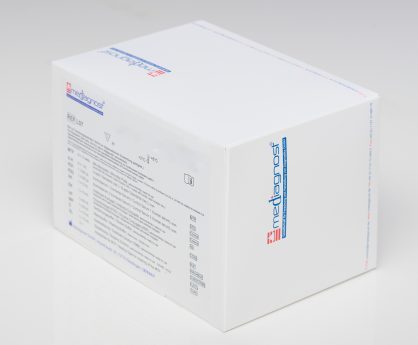Mouse Rat Leptin ELISA Assay
$665.00
The Rodent Leptin ELISA Assay measures Leptin in serum and plasma samples. The Mouse/Rat Leptin ELISA Assay Kit is for research use only.
Mouse Rat Leptin ELISA Assay
The Mouse Rat Leptin ELISA Assay is For Research Use Only
Size: 1×96 wells
Sensitivity: 10 pg/ml
Incubation Time: 3 hours
Sample Type: Serum, Plasma
Sample Size: 20 µL
Alternate Name: Mouse/Rat Leptin ELISA
Mouse / Rat Leptin ELISA Assay Kit is manufactured by Mediagnost
Related Products
Functional Leptin ELISA Assay Kit
Leptin Sensitive ELISA Assay Kit
Mouse/Rat GH ELISA Assay
Assay Notes
The Mouse/Rat Leptin ELISA has been calibrated against the International Reference Standard for mouse leptin. The definition of this international reference material, code 97/626, was evaluated in an international collaborative study, with Mediagnost test kits and with participation of Mediagnost. The standard preparation of the WHO with code 97/626 (39) is available from the NIBSC. One ampoule of the preparation, reconstituted in 1 ml solution, will be quantified with this kit E06 to the nominal content of 4000 ng mouse leptin.
Assay Background
Leptin, the product of the ob gene, is a recently discovered single-chain proteohormone with a molecular weight of 16 kD which is thought to play a key role in the regulation of body weight. Its amino acid sequence exhibits no major homologies with other proteins. Leptin is almost exclusively produced by differentiated adipocytes. It acts on the central nervous system, in particular the hypothalamus, thereby suppressing food intake and stimulating energy expenditure. Leptin receptors – alternatively spliced forms exist that differ in length – belong to the cytokine class I receptor family. They are found ubiquitously in the body indicating a general role of leptin which is currently not fully understood. A circulating form of the leptin receptor exists which acts as one of several leptin binding proteins.
Besides its metabolic effects, leptin was shown to have a strong influence on a number of endocrine axes. In male mice, it blunted the starvation-induced marked decline of LH, testosterone, thyroxine and the increase of ACTH and corticosterone. In female mice, leptin prevented the starvation-induced delay in ovulation. Ob/ob mice, which are leptin deficient due to an ob gene mutation, are infertile. This defect could be corrected by administration of leptin, but not through weight loss due to fasting, suggesting that leptin is pivotal for reproductive functions.
All these actions may, at least in part, be explained by the suppressive effect of leptin on neuropeptide Y (NPY) expression and secretion by neurons in the arcuate nucleus. NPY is a strong stimulator of appetite and is known to be involved in the regulation of various pituitary hormones, e.g. suppression of GH through stimulation of somatostatin, suppression of gonadotropins or stimulation of the pituitary-adrenal axis.
The most important variable that determines circulating leptin levels is body fat mass. Obviously, under conditions of regular eating cycles, leptin reflects the proportion of adipose tissue showing an exponential relationship. This constitutive synthesis of leptin is modulated by a number of non-hormonal and hormonal variables. Stimulators in both rodents and humans are overfeeding, high fat diets, insulin and glucocorticoids. Suppression has been shown for fasting, cAMP and beta–3-adrenoceptor agonists. From these findings it becomes clear that leptin is an integral component of various metabolic and endocrine feedback loops.
Sensitivity
The practical sensitivity of the assay is 10 pg/ml, i.e., 1 pg/well (calculated by extrapolation of the standard curve).
Package Inserts
Please note: All documents above are for reference use only and should not be used in place of the documents included with this physical product. If digital copies are needed, please contact us.


